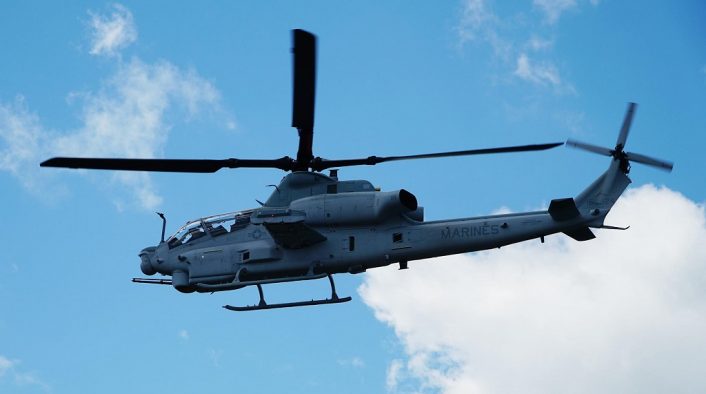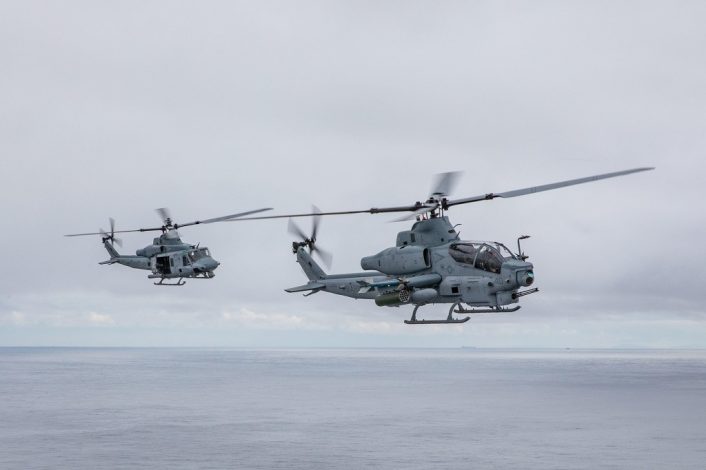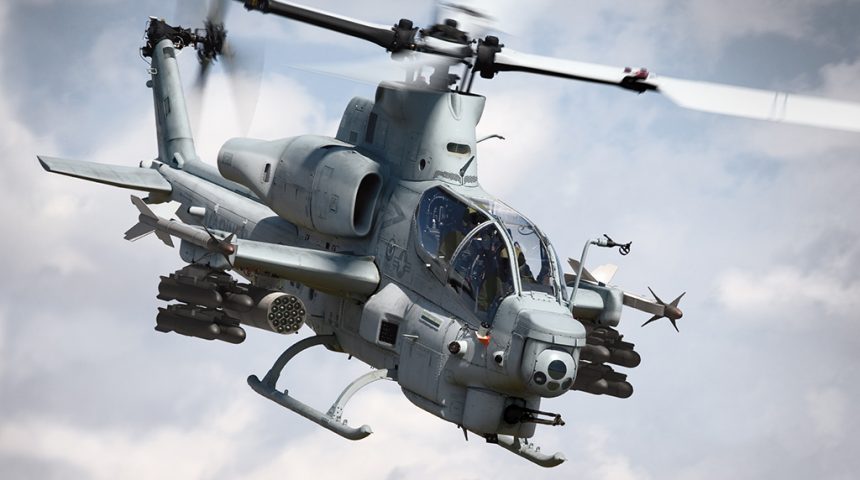The upgrade is part of the new Digital Interoperability suite that will be later extended also to the UH-1Y Venom.
An AH-1Z Viper of the Air Test and Evaluation Squadron (HX) 21 demonstrated for the first time the Link 16 to establish a two-way connection between a ground station and the helicopter during a test flight at Naval Air Station Patuxent River. The new capability is part of the digital interoperability (DI) suite, which includes Link 16 and Advanced Networking Wideband Waveform (ANW2) data links used to share information across various networks. Another novelty of the DI suite is the new digital moving map which can integrate all the info shared by other assets through the datalink for a better Situational Awareness (SA).
“The H-1 has decades of battlefield experience, it has evolved to fight in numerous environments,” said Col. Vasilios Pappas, USMC H-1 Light/Attack Helicopters program office (PMA-276) program manager. “The integration of these data links aligns with this platforms’ ability to adapt to the ever-changing threat and meet the needs of current and future warfighters.”

The Link 16 system, which was provided by Northrop Grumman, is part of a defined road map of planned improvements designed to ensure the AH-1Z Viper maintains its technological edge and combat capability throughout its service life. Thanks to the datalinks, the helicopter can now rapidly share information with other weapon systems, provide greater situational awareness, accelerate the kill chain, and enhance survivability to outmaneuver and defeat the threat across a range of military operations.
“Northrop Grumman’s Link-16 system will help U.S. Marines today, and well into the future, with critical technology that facilitates coordination, collaboration, and interoperability. By enabling the display and integration of Link-16 data with the H-1 system, pilots of the AH-1Z have greater situational awareness and enhanced survivability,” said James Conroy, vice president, navigation, targeting and survivability, Northrop Grumman. “This milestone also highlights our focus on “speed to fleet,” due to the unprecedented time between demonstrating the concept and getting to first flight. Flexibility and adaptability, using next generation agile development practices, are the only ways to innovate and keep pace with changing mission needs.”
The integration effort, supported by both Bell (the helicopter’s manufacturer) and Northrop Grumman, culminated in this first one-hour test flight, during which the pilots successfully communicated with a PRC-117G Multiband Networking Manpack Radio, one of the standard medium-range encrypted radios used by ground troops to communicate with air assets and share data and images, and the Mobile Systems Integration Lab, a ground station designed by the Naval Air Warfare Center Aircraft Division (NAWCAD) to validate the suite’s connection with the aircraft.
“The flight was a success and went exactly as expected,” said USMC Capt. Jason Grimes, the first flight pilot and H-1 project officer with HX-21. “There is still work to be done before fleet integration, but it was a step in the right direction in getting a much needed capability to the HMLA [Marine Light Attack Helicopter] squadrons.”

According to the press release, the joint team composed by the U.S. Marine Corps H-1 Light/Attack Helicopter program (PMA-276), Bell and Northrop Grumman leveraged the best practices of Agile Development methodologies to get the DI suite from concept to vehicle design testing in 12 months. Specifically, Northrop Grumman architected and integrated a mission package for Link 16 while Bell provided all of the necessary vehicle analysis and modifications to incorporate the new mission equipment on the AH-1Z.
The complete DI suite includes a new radio, processor, and mission computer software to integrate the information from this new data link onto a new digital map interface. The flight test campaign will continue throughout the summer, with the initial AH-1Z fleet integration expected in 2022. Following the completion of the AH-1Z testing, the USMC will begin the integration of the DI suite also on the UH-1Y Venom.
The news about the first test of the new capabilities arrived just a few days after the USMC announced that the H-1 mixed fleet, composed by both the AH-1Z Viper and UH-1Y Venom, surpassed the 400,000 flight hours milestone in April. The two helicopters, which are the latest variants of the AH-1 Huey Cobra and the UH-1 Huey, have been deployed around the globe since 2010. With the last UH-1Y delivered in 2018 and the last AH-1Z to be delivered in 2022, the H-1 fleet is expected to stay in service through the 2040s.
However, some of these helicopters are already headed to long-term storage at the Davis-Monthan Air Force Base’s “boneyard”, as Captain Andrew Wood, a USMC spokesperson, confirmed to our friends at The War Zone: “As a result of Force Design 2030 squadron divestments, and pending final disposition, the Marine Corps expects to induct 53 H-1s (27 AH-1Zs and 26 UH-1Ys) into long-term preservation and storage”.
Force Design 2030 is a radical restructuring effort initiated with the goal of creating a more flexible U.S. Marine Corps with new capabilities, even if this will be at the expense of other traditional capabilities which are being downsized or totally eliminated. One of the capabilities that have been eliminated quite unexpectedly, generating some controversies, is the Main Battle Tank specialty, resulting in the almost immediate divestment of the M1 Abrams tank fleet.
Back in 2019, the Marine Aviation Plan foresaw a total of 145 Vipers and 116 Venoms in service by the end of 2022. With the confirmed retirement of 53 H-1s, which already started as the 309th Aerospace Maintenance and Regeneration Group (AMARG) published the photos of the first AH-1Z being cocooned last month, the two fleets will lose about 20% of their strength.
However, there is an interesting detail. Some of the first helicopters to be retired come from the recently inactivated Marine Light Attack Helicopter Squadron 367 (HMLA-367) at Marine Corps Air Station (MCAS) Kaneohe Bay (Hawaii). The III Marine Expeditionary Force (MEF) confirmed that two of HMLA-367’s AH-1Zs were sent to the boneyard, while others are being sent to other units, and both of them are remanufactured AH-1Ws.
As you may know already, a small number of AH-1W Super Cobras and UH-1N Hueys were remanufactured in the newer AH-1Z Vipers and UH-1Y Venoms, before the USMC decided to continue the program with only newly built helicopters. This might just be speculation, but with the detail confirmed by the III MEF, we might assume that the USMC is retiring only the remanufactured helicopters to employ its resources on the newly built ones.









